Alcatel-Lucent OmniSwitch 9900 User manual
- Category
- Networking
- Type
- User manual
This manual is also suitable for

Part No. 060453-10 Rev. A
January 2017
OmniSwitch AOS Release 8
Transceivers Guide
8.3.1.R02
enterprise.alcatel-lucent.com

This user guide contains transceiver specifications and compatibility information for the
OmniSwitch AOS Release 8 and supported platforms. The information described in this guide is
subject to change without notice.
Attention: Use of any transceivers other than those part numbers listed in the Compatibility Matri-
ces is prohibited. Failure to comply with these matrices is not guaranteed for proper performance
and may result in voiding the warranty for the affected platforms.
enterprise.alcatel-lucent.com Alcatel-Lucent and the Alcatel-Lucent Enterprise logo are trademarks of
Alcatel-Lucent. To view other trademarks used by affiliated companies of ALE Holding, visit: enter-
prise.alcatel-lucent.com/trademarks. All other trademarks are the property of their respective owners. The
information presented is subject to change without notice. Neither ALE Holding nor any of its affiliates
assumes any responsibility for inaccuracies contained herein. (2017)
Service & Support Contact Information
North America: 800-995-2696
Latin America: 877-919-9526
EMEA: +800 00200100 (Toll Free) or +1(650)385-2193
Asia Pacific: +65 6240 8484
Web: support.esd.alcatel-lucent.com
Email: ebg_global[email protected]m

OmniSwitch AOS Release 8 Transceivers Guide January 2017 iii
Contents
About This Guide ........................................................................................................... v
Supported Platforms ........................................................................................................... v
Who Should Read this Manual? ........................................................................................ vi
When Should I Read this Manual? .................................................................................... vi
What is Not in this Manual? .............................................................................................. vi
How is the Information Organized? .................................................................................. vi
Documentation Roadmap .................................................................................................vii
Related Documentation ..................................................................................................... ix
Technical Support ..............................................................................................................x
Chapter 1 Small Form-Factor Pluggables (SFP/SFP+/QSFP+) ..........................................1-1
In This Chapter ................................................................................................................1-1
SFP MSA Specification ..................................................................................................1-2
Transceiver Installation and Removal .............................................................................1-3
40-Gigabit Fiber Optic Cables ........................................................................................1-6
QSFP to QSFP 40G Fiber Optic Cable ....................................................................1-6
QSFP to SFP+ Splitter Fiber Optic Cable ................................................................1-6
Gigabit Ethernet Transceivers .........................................................................................1-7
Dual Speed Ethernet Transceivers ................................................................................1-13
100 FX Ethernet Transceivers .......................................................................................1-15
10-Gigabit SFP+ Transceivers ......................................................................................1-19
40-Gigabit QSFP+ Transceivers ...................................................................................1-23
Fibre Channel Transceivers ...........................................................................................1-27
Industrial Transceivers ..................................................................................................1-28
Chapter 2 Transceiver Compatibility Matrix .........................................................................1-33
In This Chapter ..............................................................................................................1-33
OmniSwitch 10K Compatibility ...................................................................................1-34
OmniSwitch 6900 Compatibility ..................................................................................1-36
OmniSwitch 6860 Compatibility ..................................................................................1-38
OmniSwitch 6865 Compatibility ..................................................................................1-40
OmniSwitch 9900 Compatibility ..................................................................................1-41

Contents
OmniSwitch AOS Release 8 Transceivers Guide January 2017 iv

OmniSwitch AOS Release 8 Tranceivers Guide January 2017 page v
About This Guide
This OmniSwitch AOS Release 8 Transceivers Guide provides specifications and compatibility informa-
tion for the supported OmniSwitch transceivers for all OmniSwitch AOS Release 8 products.
Supported Platforms
This information in this guide applies to the following products:
• OmniSwitch 10K
• OmniSwitch 6900
• OmniSwitch 6860(E)
• OmniSwitch 6865
• OmniSwitch 9900
Unsupported Platforms
The information in this guide does not apply to the following products:
• All other platforms

About This Guide Who Should Read this Manual?
OmniSwitch AOS Release 8 Tranceivers Guide January 2017 page vi
Who Should Read this Manual?
The audience for this user guide is network administrators and IT support personnel who need to provide
network connectivity using SFP, SFP+, and QSFP+ transceivers.
When Should I Read this Manual?
Read this guide as soon as you are ready to integrate your OmniSwitch into your network and you are
ready to provide connectivity using the supported transceivers. You should have already stepped through
the first login procedures and read the brief software overviews in the appropriate OmniSwitch Hardware
Guide.
This guide includes information about the supported OmniSwitch transceivers.
• SFP/SFP+/QSFP+ specifications
• SFP/SFP+/QSFP+ compatibility information
What is Not in this Manual?
Procedures for switch management methods, such as CLI, web-based (WebView or OmniVista) or SNMP,
are outside the scope of this guide.
For information on WebView and SNMP switch management methods consult the OmniSwitch Switch
Management Guide. Information on using WebView and OmniVista can be found in the context-sensitive
on-line help available with those network management applications.
This guide is designed to provide transceiver specification and compatibility information only and is not
intended as a reference for any CLI commands or configuration information. Refer to the Documentation
Roadmap for a list of available user guides.
How is the Information Organized?
Chapters in this guide are broken down by transceiver type.
Specification Information. Each transceiver has an associated table providing individual specifications
for all supported transceivers.
Compatibility Information. A compatibility chart is provided for each transceiver specifying which
modules or switch the transceiver is supported on.

About This Guide Documentation Roadmap
OmniSwitch AOS Release 8 Tranceivers Guide January 2017 page vii
Documentation Roadmap
The OmniSwitch user documentation suite was designed to supply you with information at several critical
junctures of the configuration process.The following section outlines a roadmap of the manuals that will
help you at each stage of the configuration process. Under each stage, we point you to the manual or
manuals that will be most helpful to you.
Stage 1: Using the Switch for the First Time
Pertinent Documentation: OmniSwitch Hardware Users Guide
Release Notes
This guide provides all the information you need to get your switch up and running the first time. It
provides information on unpacking the switch, rack mounting the switch, installing NI modules, unlocking
access control, setting the switch’s IP address, and setting up a password. It also includes succinct
overview information on fundamental aspects of the switch, such as hardware LEDs, the software
directory structure, CLI conventions, and web-based management.
At this time you should also familiarize yourself with the Release Notes that accompanied your switch.
This document includes important information on feature limitations that are not included in other user
guides.
Stage 2: Gaining Familiarity with Basic Switch Functions
Pertinent Documentation: OmniSwitch Hardware Users Guide
OmniSwitch AOS Release 8 Switch Management Guide
Once you have your switch up and running, you will want to begin investigating basic aspects of its
hardware and software. Information about switch hardware is provided in the OmniSwitch 10K Hardware
Guide. This guide provide specifications, illustrations, and descriptions of all hardware components, such
as chassis, power supplies, Chassis Management Modules (CMMs), Network Interface (NI) modules, and
cooling fans. It also includes steps for common procedures, such as removing and installing switch
components.
This guide is the primary users guide for the basic software features on a single switch. This guide
contains information on the switch directory structure, basic file and directory utilities, switch access
security, SNMP, and web-based management. It is recommended that you read this guide before
connecting your switch to the network.
Stage 3: Integrating the Switch Into a Network
Pertinent Documentation: OmniSwitch AOS Release 8 Network Configuration Guide
OmniSwitch AOS Release 8 Advanced Routing Configuration Guide
OmniSwitch AOS Release 8 Data Center Switching Guide
When you are ready to connect your switch to the network, you will need to learn how the OmniSwitch
implements fundamental software features, such as 802.1Q, VLANs, Spanning Tree, and network routing
protocols. The Network Configuration Guide contains overview information, procedures, and examples on
how standard networking technologies are configured on the OmniSwitch.
The Advanced Routing Guide includes configuration information for networks using advanced routing
technologies (OSPF and BGP) and multicast routing protocols (DVMRP and PIM-SM).
The Data Center Switching Guide includes configuration information for data center networks using
virtualization technologies (SPBM and UNP) and Data Center Bridging protocols (PFC, ETC, and
DCBX).

About This Guide Documentation Roadmap
OmniSwitch AOS Release 8 Tranceivers Guide January 2017 page viii
Anytime
The OmniSwitch AOS Release 8 CLI Reference Guide contains comprehensive information on all CLI
commands supported by the switch. This guide includes syntax, default, usage, example, related CLI
command, and CLI-to-MIB variable mapping information for all CLI commands supported by the switch.
This guide can be consulted anytime during the configuration process to find detailed and specific
information on each CLI command.

About This Guide Related Documentation
OmniSwitch AOS Release 8 Tranceivers Guide January 2017 page ix
Related Documentation
The following are the titles and descriptions of all the OmniSwitch user manuals:
• OmniSwitch 10K/9900/6900/6860/6865 Hardware Users Guides
Describes the hardware and software procedures for getting an OmniSwitch up and running as well as
complete technical specifications and procedures for all OmniSwitch chassis, power supplies, fans, and
Network Interface (NI) modules.
• OmniSwitch AOS Release 8 CLI Reference Guide
Complete reference to all CLI commands supported on the OmniSwitch. Includes syntax definitions,
default values, examples, usage guidelines and CLI-to-MIB variable mappings.
• OmniSwitch AOS Release 8 Switch Management Guide
Includes procedures for readying an individual switch for integration into a network. Topics include
the software directory architecture, image rollback protections, authenticated switch access, managing
switch files, system configuration, using SNMP, and using web management software (WebView).
• OmniSwitch AOS Release 8 Network Configuration Guide
Includes network configuration procedures and descriptive information on all the major software
features and protocols included in the base software package. Chapters cover Layer 2 information
(Ethernet and VLAN configuration), Layer 3 information (routing protocols, such as RIP and IPX),
security options (authenticated VLANs), Quality of Service (QoS), link aggregation, and server load
balancing.
• OmniSwitch AOS Release 8 Advanced Routing Configuration Guide
Includes network configuration procedures and descriptive information on all the software features and
protocols included in the advanced routing software package. Chapters cover multicast routing
(DVMRP and PIM-SM), Open Shortest Path First (OSPF), and Border Gateway Protocol (BGP).
• OmniSwitch AOS Release 8 Data Center Switching Guide
Includes and introduction to the OmniSwitch data center switching architecture as well as network
configuration procedures and descriptive information on all the software features and protocols that
support this architecture. Chapters cover Shortest Path Bridging MAC (SPBM), Data Center Bridging
(DCB) protocols, Virtual Network Profile (vNP), and the Edge Virtual Bridging (EVB) protocol.
• OmniSwitch AOS Release 8 Transceivers Guide
Includes transceiver specifications and product compatibility information.
• OmniSwitch AOS Release 8 Specifications Guide
Includes Specifications table information for the features documented in the Switch Management
Guide, Network Configuration Guide, Advanced Routing Guide, and Data Center Switching Guide.
• Technical Tips, Field Notices
Includes information published by Alcatel’s Customer Support group.
• Release Notes
Includes critical Open Problem Reports, feature exceptions, and other important information on the
features supported in the current release and any limitations to their support.

About This Guide Technical Support
OmniSwitch AOS Release 8 Tranceivers Guide January 2017 page x
Technical Support
An Alcatel-Lucent service agreement brings your company the assurance of 7x24 no-excuses technical
support. You’ll also receive regular software updates to maintain and maximize your Alcatel-Lucent
product’s features and functionality and on-site hardware replacement through our global network of
highly qualified service delivery partners.
With 24-hour access to Alcatel-Lucent Enterprise Service and Support web page, you’ll be able to view
and update any case (open or closed) that you have reported to Alcatel-Lucent Enterprise technical
support, open a new case or access helpful release notes, technical bulletins, and manuals.
Access additional information on Alcatel-Lucent Enterprise Programs:
Web: support.esd.alcatel-lucent.com
Phone: 1-800-995-2696
Email: ebg_global_supportcenter@al-enterprise.com

OmniSwitch AOS Release 8 Transceivers Guide January 2017 page 1-1
1 Small Form-Factor
Pluggables (SFP/SFP+/QSFP+)
OmniSwitch Series switches use both copper-based and fiber-based optical Small Form Factor Pluggable
transceivers. These transceivers are fully hot-swappable and are available for both short-reach and long-
reach applications. Copper-based and fiber-based optical transceivers can be mixed on the same module.
In This Chapter
This chapter describes the technical specifications for all the OmniSwitch supported transceivers. For
additional details about OmniSwitch modules, see the appropriate OmniSwitch Hardware Guide.
Transceiver specifications in this chapter include:
• SFP MSA Specifications. See “SFP MSA Specification” on page 1-2.
• Transceiver Installation. See “Transceiver Installation and Removal” on page 1-3.
• 40-Gigabit Fiber Optic Cable Overview. See “40-Gigabit Fiber Optic Cables” on page 1-6.
• Gigabit Ethernet Transceivers. See “Gigabit Ethernet Transceivers” on page 1-7.
• Dual Speed Ethernet Transceivers. See “Dual Speed Ethernet Transceivers” on page 1-13.
• 100-FX Ethernet Transceivers. See “100 FX Ethernet Transceivers” on page 1-15.
• 10-Gigabit SFP+ Transceivers. See “10-Gigabit SFP+ Transceivers” on page 1-19.
• 40-Gigabit QSFP+ Transceivers. See “40-Gigabit QSFP+ Transceivers” on page 1-24.
• 40-Gigabit QSFP+ Transceivers. See “Industrial Transceivers” on page 1-29.
• Fibre Channel Transceivers. See “Fibre Channel Transceivers” on page 1-28.
• For a transceiver compatibility matrix, see “Transceiver Compatibility Matrix” on page 2-34.

SFP MSA Specification Small Form-Factor Pluggables (SFP/SFP+/QSFP+)
page 1-2 OmniSwitch AOS Release 8 Transceivers Guide January 2017
SFP MSA Specification
The Small Form-Factor Pluggable (SFP) MSA (Multi Source Agreement) is a specification for a common
interface for optical modular transceivers. The SFP connector consists of a 20-pin receptacle and an SFP
housing cage. The connector provides the interface for the hot pluggable SFP module. Each SFP module
contains a serial interface to provide identification information that describes the SFP capabilities, stand
interfaces, manufacturer and other information.
For information on installing SFPs, refer to the documentation included with the transceiver.
Small Form Factor Pluggable (SFP)
This diagram is a representation
only; the physical appearance of the
actual module may vary slightly.

Small Form-Factor Pluggables (SFP/SFP+/QSFP+) Transceiver Installation and Removal
OmniSwitch AOS Release 8 Transceivers Guide January 2017 page 1-3
Transceiver Installation and Removal
Follow the instructions below for the appropriate transceiver type.
ESD Caution: Before handling the module, you must discharge all static electricity on your person to
avoid Electrostatic Discharge (ESD) damage. If using a wrist strap, ensure that the wrist strap touches
your skin. Attach the other end of the strap to the chassis. If your chassis provides a grounding lug, this
can be used. Refer to your hardware user guide for details.
If using a wrist strap, ensure that the wrist strap touches your skin. Attach the other end of the strap to the
chassis. If your chassis provides a grounding lug, this can be used. Refer to your hardware user guide for
details.
Dust Exposure: To reduce the risk of dust exposure and physical damage, be sure to replace the protec-
tive rubber cover (provided) when the SFP is not in use.
Eye Safety: SFP transceivers are international Class 1 laser products and are eye-safe devices when oper-
ated within the limits of manufacturers’ specifications. Operating SFP transceivers in a manner inconsis-
tent with intended usage and specification may result in hazardous radiation exposure.
Note: After removing a transceiver, wait for a minimum of 5 seconds before re-inserting any transceiver
into the same port. This allows sufficient time for software to detect the removal of the transceiver.
Note: Never force the transceiver in or out of the transceiver slot.
SFP - Hinged
To remove, you must first open the SFP’s hinged face to approximately ninety
degrees. Then, grasp the hinged face and carefully pull the SFP straight out of
the slot.
When inserting a SFP, be sure that the hinged face is closed. Slide the SFP
straight into the slot until the module clicks firmly into place.
SFP Module
Interface Slot

Transceiver Installation and Removal Small Form-Factor Pluggables (SFP/SFP+/QSFP+)
page 1-4 OmniSwitch AOS Release 8 Transceivers Guide January 2017
SFP - Bail Wire
SFP - Ejector Button
To install, align the transceiver with the transceiver slot on the
NI module, as shown. Be sure that the bail wire delatch is in the
up, or closed position. Slide the transceiver straight into the slot
until the module clicks firmly into place.
SFP Transceiver
Network Interface (NI)
Module
To remove, you must first pull down on the bail
wire delatch. Grip the wire delatch while it is in this
open position and carefully pull the transceiver
straight out of the slot.
Bail Wire Delatch
Transceiver Slot
(Shown in open “removal” posi-
tion; when inserting, bail
delatch must be closed.)
To install, align the transceiver with the
transceiver slot on the NI module, as
shown. Carefully slide the transceiver
back until it clicks into place; this is an
indication that the connectors are firmly
seated.
SFP Transceiver
Network Interface (NI) Module
To remove, use the ejector tool (provided
with each switch chassis) to push the trans-
ceiver’s ejector button. The ejector button is
located just below the transceiver port; refer
to the diagram for more information. The
transceiver will disengage from the connec-
tors and eject slightly. Once disengaged, use
the clip end of the ejector tool to carefully
pull the transceiver straight out and away
from the NI module.
Dust Cover
Ejector
Transceiver Slot

Small Form-Factor Pluggables (SFP/SFP+/QSFP+) Transceiver Installation and Removal
OmniSwitch AOS Release 8 Transceivers Guide January 2017 page 1-5
QSFP+ - Removal
To install, align the transceiver with the
transceiver slot on the NI module, as
shown. Carefully slide the transceiver
back until it clicks into place; this is an
indication that the connectors are firmly
seated.
QSFP+ Transceiver
Network Interface (NI) Module
To remove, use the rubber or metal ejector
handle and pull transceiver straight out and
away from the NI module.
Note: Never force the transceiver in or out of
the transceiver slot.
Transceiver Slot
Handle

40-Gigabit Fiber Optic Cables Small Form-Factor Pluggables (SFP/SFP+/QSFP+)
page 1-6 OmniSwitch AOS Release 8 Transceivers Guide January 2017
40-Gigabit Fiber Optic Cables
QSFP to QSFP 40G Fiber Optic Cable
To directly connect two Omniswitches with a 40G transceiver, an MPO trunk cable can be used. The cable
can have 8 or 12 fibers, however, the 40G standard only uses 8 fibers. The cable should be a Type-B cross-
over cable. This type of cable should be used with the QSFP-40G-SR transceiver.
Example Type B - MPO Cable Connection
QSFP to SFP+ Splitter Fiber Optic Cable
To connect a 40G transceiver to four 10G transceivers an MTP-LC splitter cable can be used. The MPO-
LC cable has eight fibers that connect the 40G MPO connector to four 10G LC connectors. This type of
cable should be used with the QSFP-4X10G-SR
transceiver. The LC connectors can be manually
rearranged to meet the necessary transmit/receive requirements.
Example MPO/LC Splitter Cable
Fiber12345-89101112
Type A
MPO1 Tx1 Tx2 Tx3 Tx4 N/A Rx4 Rx3 Rx2 Rx1
MPO2 Rx1 Rx2 Rx3 Rx4 N/A Tx4 Tx3 Tx2 Tx1
Fiber12345-89101112
Type B
Fiber12345-89101112
MPO1 Rx1 Rx2 Rx3 Rx4 N/A Tx4 Tx3 Tx2 Tx1
MPO2 Tx1 Tx2 Tx3 Tx4 N/A Rx4 Rx3 Rx2 Rx1
Fiber12111095-84321
QSFP
QSFP
MPO Connectors
LC/SFP4
LC/SFP2
LC/SFP3
LC/SFP1
MPO

Small Form-Factor Pluggables (SFP/SFP+/QSFP+) Gigabit Ethernet Transceivers
OmniSwitch AOS Release 8 Transceivers Guide January 2017 page 1-7
Gigabit Ethernet Transceivers
SFP-GIG-SX
Gigabit SFP Optical Transceiver.
Connector Type LC
Standards Supported 802.3z, SFP MSA
Connections Supported 1000Base-SX
Fiber Type MMF
Wavelength 850 nm
Optical Power Output -9.0 to -2.5 dBm
Receiver Sensitivity -17 dBm
Transmission Distance ~300 m on 62.5/125µm
~550 m on 50/125µm
Operating Temperature -20 ºC to 85ºC
Digital Diagnostic Monitoring Supported (Alcatel-Lucent branded transceivers only)
SFP-GIG-LX
Gigabit SFP Optical Transceiver.
Connector types LC
Standards supported 802.3z, SFP MSA
Connections supported 1000Base-LX
Fiber Type SMF
Wavelength 1310 nm
Optical Power Output -9.5 to -3 dBm
Receiver Sensitivity -14.5 dBm
Transmission Distance
10 km
Operating Temperature -40 ºC to 85 ºC / 0 ºC to 70 ºC
Digital Diagnostic Monitoring Supported (Alcatel-Lucent branded transceivers only)

Gigabit Ethernet Transceivers Small Form-Factor Pluggables (SFP/SFP+/QSFP+)
page 1-8 OmniSwitch AOS Release 8 Transceivers Guide January 2017
SFP-GIG-LH40
Gigabit SFP Optical Transceiver.
Connector Type LC
Standards Supported 802.3z, SFP MSA
Connections Supported 1000Base-LH40r
Fiber Type SMF
Wavelength 1310 nm
Optical Power Output 0 to +5 dBm
Receiver Sensitivity -22 dBm
Transmission Distance ~40 km
Operating Temperature -10 ºC to 70 ºC
Digital Diagnostic Monitoring Supported
SFP-GIG-LH70
Gigabit SFP Optical Transceiver.
Connector Type LC
Standards Supported 802.3z, SFP MSA
Connections Supported 1000Base-LH70
Fiber Type SMF
Wavelength 1550 nm
Optical Power Output 0 to +5 dBm
Receiver Sensitivity -22 dBm
Transmission Distance ~70 km
Operating Temperature -10 ºC to 70 ºC
Digital Diagnostic Monitoring Supported

Small Form-Factor Pluggables (SFP/SFP+/QSFP+) Gigabit Ethernet Transceivers
OmniSwitch AOS Release 8 Transceivers Guide January 2017 page 1-9
SFP-GIG-CWD
Coarse Wavelength Division Multiplexing (CWDM) is an optical transceiver supporting single-mode fiber
over various wavelengths. CWDMs are hot-pluggable and are available for long-reach applications.
Connector Type LC
Standards Supported 802.3z, SFP MSA
Connections Supported 1000Base-LX
Fiber Type SMF
Wavelength 1470, 1490, 1510, 1530, 1550, 1570, 1590, 1610
Optical Power Output -2 to +3 dBm
Receiver Sensitivity -24 dBm
Transmission Distances ~62 km
Operating Temperature -5 ºC to 70 ºC
Digital Diagnostic Monitoring Not Supported
SFP-GIG-T
Gigabit SFP Copper Transceiver.
Connector Type RJ-45
Standards Supported 802.3z, SFP MSA
Connections supported 10/100/1000Base-T
Cable Type CAT5, CAT5e, CAT6
Transmission Distance
100 m
Digital Diagnostic Monitoring Not Supported
SFP-GIG-EXTND
Gigabit SFP Optical Transceiver.
Connector Type LC
Standards Supported 802.3, SFP MSA
Connections Supported -
Fiber Type MMF
Wavelength 1310 nm
Saturation Power 0 dBm
Transmission Distance ~2 km
Operating Temperature 0 ºC to 70 ºC
Digital Diagnostic Monitoring Supported

Gigabit Ethernet Transceivers Small Form-Factor Pluggables (SFP/SFP+/QSFP+)
page 1-10 OmniSwitch AOS Release 8 Transceivers Guide January 2017
SFP-GIG-BX-D
Bi-Directional SFP Optical Transceiver.
Connector Type LC
Standards Supported 802.3ah, SFP MSA
Connections Supported 1000Base-BX10
Fiber Type SMF
Wavelength Transmit: 1490 nm
Receive: 1310 nm
Average Power Output -9 to -3 dBm
Receiver Sensitivity -19.5 dBm
Transmission Distance ~10 km
Operating Temperature 0 ºC to 70 ºC
Digital Diagnostic Monitoring Supported
Notes Designed for use with SFP-GIG-BX-U
SFP-GIG-BX-U
Bi-Directional SFP Optical Transceiver.
Connector Type LC
Standards Supported 802.3ah, SFP MSA
Connections Supported 1000Base-BX10
Fiber Type SMF
Wavelength Transmit: 1310 nm
Receive: 1490 nm
Average Power Output -9 to -3 dBm
Receiver Sensitivity -19.5 dBm
Transmission Distance ~10 km
Operating Temperature 0 ºC to 70 ºC
Digital Diagnostic Monitoring Supported
Notes Designed for use with SFP-GIG-BX-D
Page is loading ...
Page is loading ...
Page is loading ...
Page is loading ...
Page is loading ...
Page is loading ...
Page is loading ...
Page is loading ...
Page is loading ...
Page is loading ...
Page is loading ...
Page is loading ...
Page is loading ...
Page is loading ...
Page is loading ...
Page is loading ...
Page is loading ...
Page is loading ...
Page is loading ...
Page is loading ...
Page is loading ...
Page is loading ...
Page is loading ...
Page is loading ...
Page is loading ...
Page is loading ...
Page is loading ...
Page is loading ...
Page is loading ...
Page is loading ...
Page is loading ...
Page is loading ...
Page is loading ...
-
 1
1
-
 2
2
-
 3
3
-
 4
4
-
 5
5
-
 6
6
-
 7
7
-
 8
8
-
 9
9
-
 10
10
-
 11
11
-
 12
12
-
 13
13
-
 14
14
-
 15
15
-
 16
16
-
 17
17
-
 18
18
-
 19
19
-
 20
20
-
 21
21
-
 22
22
-
 23
23
-
 24
24
-
 25
25
-
 26
26
-
 27
27
-
 28
28
-
 29
29
-
 30
30
-
 31
31
-
 32
32
-
 33
33
-
 34
34
-
 35
35
-
 36
36
-
 37
37
-
 38
38
-
 39
39
-
 40
40
-
 41
41
-
 42
42
-
 43
43
-
 44
44
-
 45
45
-
 46
46
-
 47
47
-
 48
48
-
 49
49
-
 50
50
-
 51
51
-
 52
52
-
 53
53
Alcatel-Lucent OmniSwitch 9900 User manual
- Category
- Networking
- Type
- User manual
- This manual is also suitable for
Ask a question and I''ll find the answer in the document
Finding information in a document is now easier with AI
Related papers
-
Alcatel-Lucent OmniSwitch AOS 7 User manual
-
Alcatel-Lucent OmniSwitch 6350 Owner's manual
-
Alcatel-Lucent OmniSwitch 6450 User manual
-
Alcatel-Lucent OS6560-P24Z24 Hardware User's Manual
-
Alcatel-Lucent OmniSwitch 9000 Series User manual
-
Alcatel-Lucent OmniSwitch 6860E Hardware User's Manual
-
Alcatel-Lucent OmniSwitch 6860E Hardware User's Manual
-
Alcatel-Lucent OmniSwitch 6860E Hardware User's Manual
-
Alcatel-Lucent OmniSwitch 6900 Hardware User's Manual
-
Alcatel-Lucent OmniSwitch AOS 7 User manual
Other documents
-
Add-On Computer Peripherals (ACP) ADD-PCIE-2SFP+ Datasheet
-
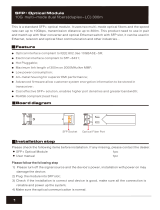 UTEPO SFP-10G-300M User manual
UTEPO SFP-10G-300M User manual
-
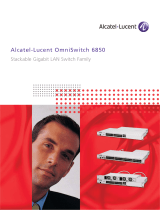 Riverstone Networks 6850 User manual
Riverstone Networks 6850 User manual
-
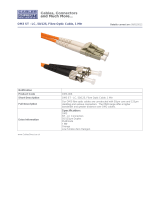 Cables Direct OM3-006 Datasheet
Cables Direct OM3-006 Datasheet
-
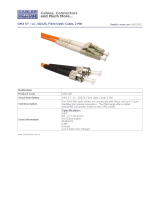 Cables Direct OM3-007 Datasheet
Cables Direct OM3-007 Datasheet
-
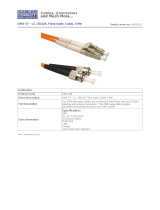 Cables Direct OM3-008 Datasheet
Cables Direct OM3-008 Datasheet
-
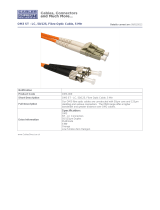 Cables Direct OM3-009 Datasheet
Cables Direct OM3-009 Datasheet
-
Add-On Computer Peripherals (ACP) ADD-MCC40GQSFP User manual
-
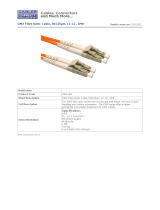 Cables Direct OM3-001 Datasheet
Cables Direct OM3-001 Datasheet
-
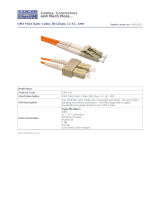 Cables Direct OM3-011 Datasheet
Cables Direct OM3-011 Datasheet




























































